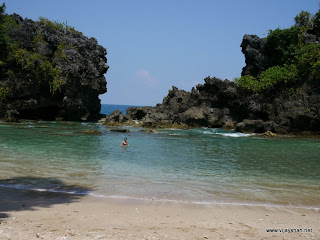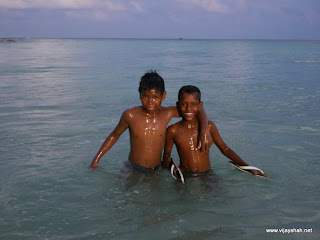The Indian tourist is a creature far removed fro their Western
counterpart. Although they find themselves in the same environment the
differences between the two cultures is almost tantamount to the
difference between species.
On Elephanta beach both species
gather, the Indian species in herds grouping together and the Western
species in small groups of two or even solitary creatures, normally
young males. The Western species spurns the bustle and noise that the
herds of Indians create and continues some way off away in the search
for privacy. Even then the small groups of Western tourists do not
gather. If one group happens upon another a quick greeting is exchanged
before the newer group has to continue some way away leaving a gap of
about 20-50m before settling to rest. This gap can be reduced is some
obstacle can be found between the groups. The western tourists activity
for the day is to bathe in the heat of the midday sun much like a
lizard would but in an attempt to bronze their white skin. They will
swim, read and and sleep too. About 50% of the tourists will burn under
the strength of the tropical sun which they typically underestimate and
their prized sun kissed skin would peel away unforgivingly. Their
dress is minimalist, exposing as much skin as possible to the sun's
rays. The male of which is typically in beach shorts, the female in a
small bikini top and bottom. Fortunately for them they tend to be
strong swimmers allowing them to enjoy their autonomy with minimal risk.
The
Indian species is very much the opposite. As mentioned earlier they
group together in herds of 50 to 100. Their love of the beach is
typically accompanied with a great fear of water. They typically cannot
swim, but even those that can are still afraid of the large fauna that
reside below the surface. At Elephanta beach they come for water
sports, to hang out with friends and not for privacy. As opposed to
their Western counterparts who will be here for weeks they have only a
few days to experience everything. Catering for this need are
entrepreneurial Indians who provide guided snorkeling trips on the sea
side. The usual mask and snorkel equipment is augmented with floats and
inflatable rings to help the tourists keep themselves afloat. Even in
the water they group together, splashing around in the shallows as herds
do. Their inexperience with water and boats make them yearn for the
other tricks that the entrepreneur provides. Motor boats rides, banana
boats and jet skis are all popular with the Indian tourists. These
activities occur within the same confines of the snorkeler meaning that
the herd mentality becomes a danger as opposed to a safety net. But all
of these activities remain for the new young and adventurous Indian
tourist. Older and less intrepid tourists resort to enjoying the sea
from the safety of the beach. They wade in the water up to knee high
and take pictures of each other enjoying themselves. Picture taking and
good quality cameras is relatively new for this species and so their
enthusiasm is endless. They take several photos of each event or pose
and sometimes their poses do not reflect reality. 'This is me making a
sand castle' or 'Thisis me relaxing on a horizontal tree trunk by the
water.' The photos suggests that these activities have occurred but in
actual fact, and I bear witness to this, they did not build a sand
castle or relax on the log for any duration of time greater than to take
the photograph. Sometimes splinter groups emerge from the herd,
typically family units that head away in the direction of the less
populated beach that is interspersed with the Western tourists. To the
Western tourists the stretch of beach is full but to the Indians it is
empty. They find a space between groups of Western tourists to picnic
and relax in. The Western tourist feeling threatened and crowded packs
up and moves away whilst the Indian tourists remain oblivious to the
fuss they have caused. The Indian tourists dress is far more elaborate
and conservative. They are fully dressed, T-shirt, shorts and sun
glasses for the male and full length dress and shades for the female.
The outfits perform two functions, firstly it lessens the impact of the
strong sun on their light brown skin which would otherwise turn them a
dark brown to black colour suggesting servitude and poverty. The second
reason is due to cultural sensitivity where showing too much skin in
unacceptable.
The reader upon hearing of these descriptions must
agree that although physically very similar the behaviour between the
two groups suggests completely different species.














































